Cheerful chrysanthemums brighten up outdoor spaces across USDA zones 5 to 9. Their colorful flowers and easy-grow nature mean they’re a popular choice, but many folks wonder how they can make the most of their display and keep them blooming for as long as possible. Let’s take a closer look at their care requirements and answer the frequently asked question, “How often do you water mums?”

Hardy chrysanthemums grow in USDA zones 5-9.
©StopperOhana/Shutterstock.com
What Is a Mum?
“Mum” is a shortened version of the name chrysanthemum. This glorious plant is a herbaceous perennial which means it grows back each year. However, whether it grows back depends on your growing zone. More on that later.
It’s a tricky name to spell, but chrysanthemums get their long name from the Greek for “gold flower.”
There are at least 40 species and numerous cultivars available and they’re generally classified as hardy garden mums or florist mums. Hardy mums are shorter, tougher plants that cope with a myriad of garden soils, whereas florists mums tend to adorn bridal bouquets. This type is less hardy, but the flower heads grow larger.
Mums begin to flower in late summer and keep blooming throughout fall. Their colors, shapes, and scent boost a yard that’s starting to lose its bloom, and they feed pollinators with essential nectar late in the season.

Stunning chrysanthemums bloom during summer and late fall.
©Dorothy Adaha Kayina/Shutterstock.com
Appearance
Many-colored mums boast white, pink, red, purple, wine, and multi-colored shades, often with yellow pollinator landing-pad centers. Depending on the species, single or multi-flowering heads sit atop a dark green stem that emerges from the root. Alternating ovate dark green leaves run their stiff stem’s length.
Native Range
Mums originate from China, eastern Asia, and northeastern Europe. Cultivated in China as a medicinal herb, mums were first introduced to Japan and then into the Western world in the 1600s.
Do Mums Come Back Every Year?
Chrysanthemums are perennial in their native habitat, which means they’re designed to grow back each year, but in colder USDA regions, some species don’t have the hardiness to survive a cold, wet winter.
Southern gardeners can expect their perennial mums to flower twice a year in spring and fall. Northerners need specific hardy cultivars that withstand zone 5 or 6 winters. Alternatively, treat them as annuals.
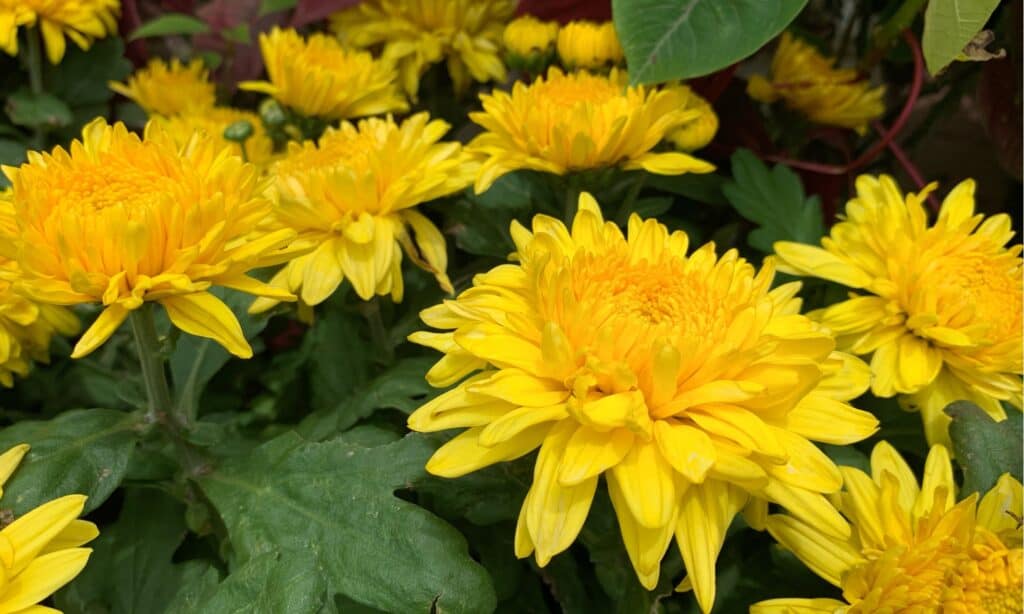
Southern gardeners can expect perennial mums to flower twice a year.
©iStock.com/Lanywati Lanywati
Toxicity
Chrysanthemum is used widely in Eastern medicine, and the petals make a refreshing tea, but they’re toxic to cats and dogs.
How Often Should You Water Mums?
“How often do you water mums?” is a frequently asked question, and there’s no definitive answer other than “whenever they need it.” Dry, stressed mums drop their petals and can’t develop new flowerheads, so enough water is important to keep that glorious display in tip-top condition.
In summer, this might be every day, but the frequency depends on your zone, weather, and whether your mums grow in full sun or part shade.
Border mums usually need less water than container-grown mums because pots dry out very quickly, even if the rain hasn’t stopped pouring. In late spring, summer, and early fall, containers need water every other day.
Tough chrysanthemums can cope with occasional dry soil, but repeated dry spells damage their cells, and they’ll have to give up. On the other hand, too much water leads to root rot and fungal disease, especially during the darker and wetter fall months.
To check if mums need water, you need to test the soil. If it’s dry on top, your mums need to drink, but if it’s still damp, hold off and check again the following day.
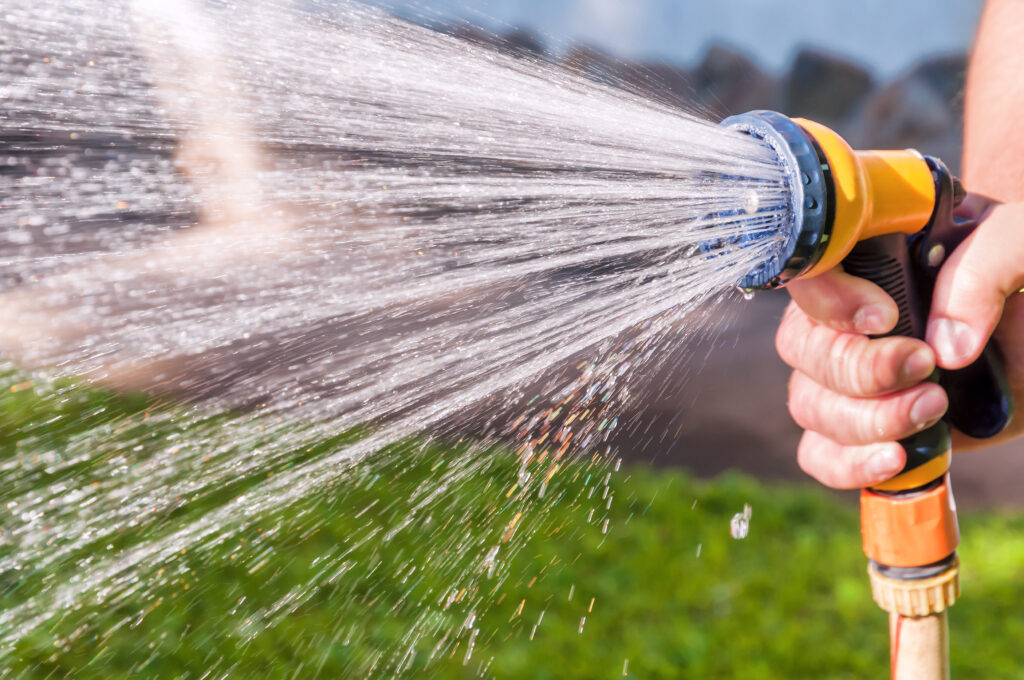
Water mums from the base not their foliage. Wet foliage leads to mold and mildew issues.
©iStock.com/vovashevchuk
How to Water Mums
So, we know that watering mums is important because dry, stressed mums give up the ghost, but what’s the best way to water them?
The most important piece of advice is to water the roots, not the foliage. Imagine feeling thirsty, but someone pours a glass of crisp, cool water on your head. That’s what it’s like for parched mums if you drench their flower heads and stems instead of the roots. A secondary issue is that wet foliage creates mold and mildew that rots and destroys the display.
You’ve got to get beneath their thick foliage to water mums properly. Drench their soil thoroughly. It’s much better to give mums a drenching twice a week than a dribble each day. Let the water sink in before adding more.
If your mums grow in a container, make sure it has drainage holes. It’s tempting to seal them up so the water doesn’t run away, but soggy soil rots all plant roots except marginal pond plants. Excess water must run off, or it’ll destroy your mums from below.
How to Save Water
To cut down on the amount of water it takes to keep plants alive, surround their roots with a thick layer of mulch, preferably organic matter, so it doubles as fertilizer. This mulch will trap water, cut down on weed competition, and shade roots from the drying sunshine and wind.
To avoid evaporation, try to water your mums when the sun is low. The early morning or late evening is best.
Think about an irrigation system. This does not need to be an expensive set-up; a leaky hose does a good job. Take an old garden hose and make holes along its length. If you lie it amongst the mums and turn on the tap. Voila! They get essential water around the roots with none wasted on their foliage.
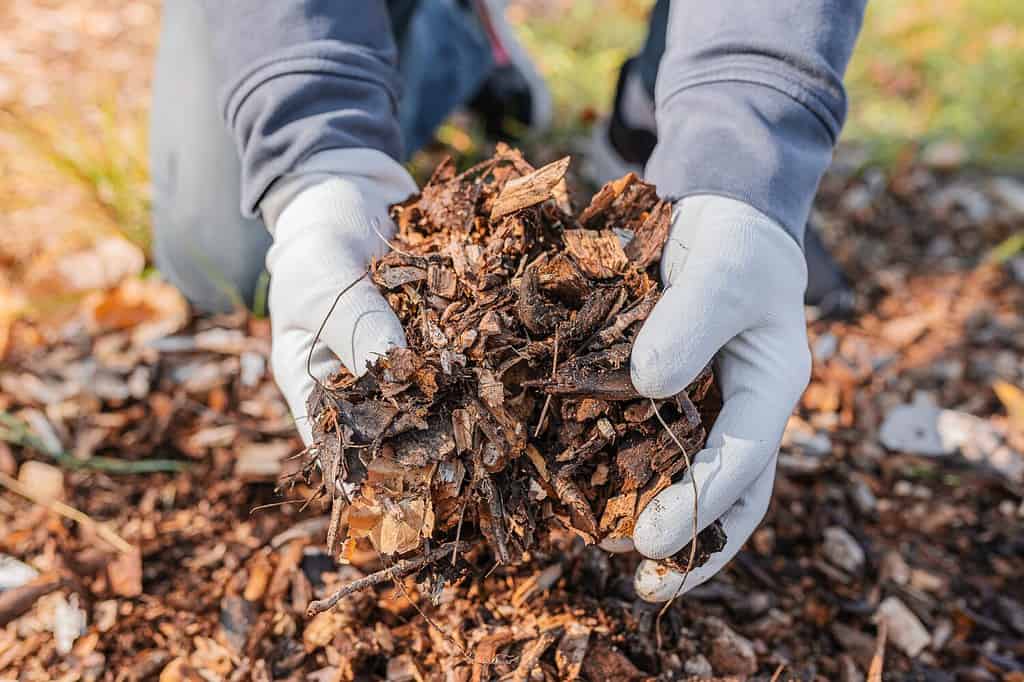
Applying organic mulch to mum roots traps water and cuts down usage.
©larisa Stefanjuk/Shutterstock.com
Critical Care Tips for Gorgeous Mums
Watering sorted!
What else will create a stunning display of mums? Here are six critical care tips.
1. Where to Plant Mums
Mums like full sun or partial shade. In full shade, they’ll get leggy and won’t develop flowerheads.
Plant hardy mums out in early spring when the frost has passed. You can grow them from seeds planted eight weeks before early spring or buy garden-ready plug plants.
Check the packet for spacings because some mums grow pretty large and need 30 or more inches between each plant. Good air circulation is important to banish mold and mildew, so try not to scrimp in space.
Plant them in the soil at the same level as the pot. Any deeper and the stems begin to rot.
2. Best Soil for Mums
Mums like free-draining soil and lots of organic matter. They’re heavy feeders that appreciate lots of nutrients. If your garden soil is chalky or sandy, bulk it up with well-rotted organic matter. Container mums do well in standard garden compost.
3. Light Requirements
Sun-loving mums like to feel the full sunshine on their faces. A sunny spot is essential to get the best from each plant, so give them at least six hours of sun a day. Early morning sunshine is the best.
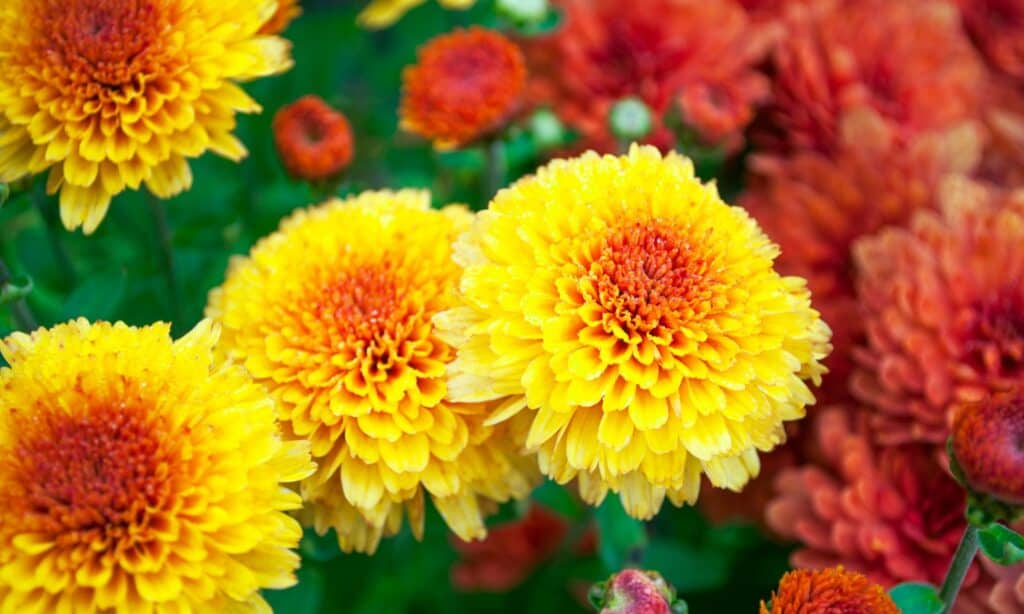
Mums need at least six hours of sunlight every day to produce the brightest blooms.
©Elan Havrilyuk/Shutterstock.com
4. Fertilizer
It’s hungry work developing such intricate flowerheads all summer and fall. Mums need fertilizer to keep their blooms healthy. Liquid fertilizer is essential for containerized mums. Choose a 10-10-10 balanced fertilizer and apply it weekly in the growing season.
Border-grown mums don’t need as much, and the best way to feed them is organic mulch.
5. Pruning
Deadheading mums as flowers pass their best keep the bloom coming. It’s because flowers exist to attract pollinators, and when they’re pollinated, they mature into seed heads. If you remove developing seed heads, the plant will create more flowers for fertilization.
Cut off spent flower heads just above the highest leaf with a sharp pair of secateurs.
6. Companion Plants for Fall
Beautiful mums create a late summer-to-fall splash, and they look great with other fall-time plants. Here are some companion plant suggestions to create a pollinator-friendly, colorful fall-time display.
- Salvias – late flowering salvias bring height, color, and nectar to a fall-time yard.
- Sedums – butterfly favorite sedums blast a border with intense pink shades.
- Asters – purple, pink, or white daisy-like asters bloom all fall.
- Coneflowers – North American native coneflowers bloom until the frosts and attract pollinators.
- Ornamental grasses – try festuca or black mondo grass.
Grasses? Yes! Grasses benefit birds and small mammals who use their dried stems for nesting. Grasses also create movement and texture. It can’t all be about bright colors!
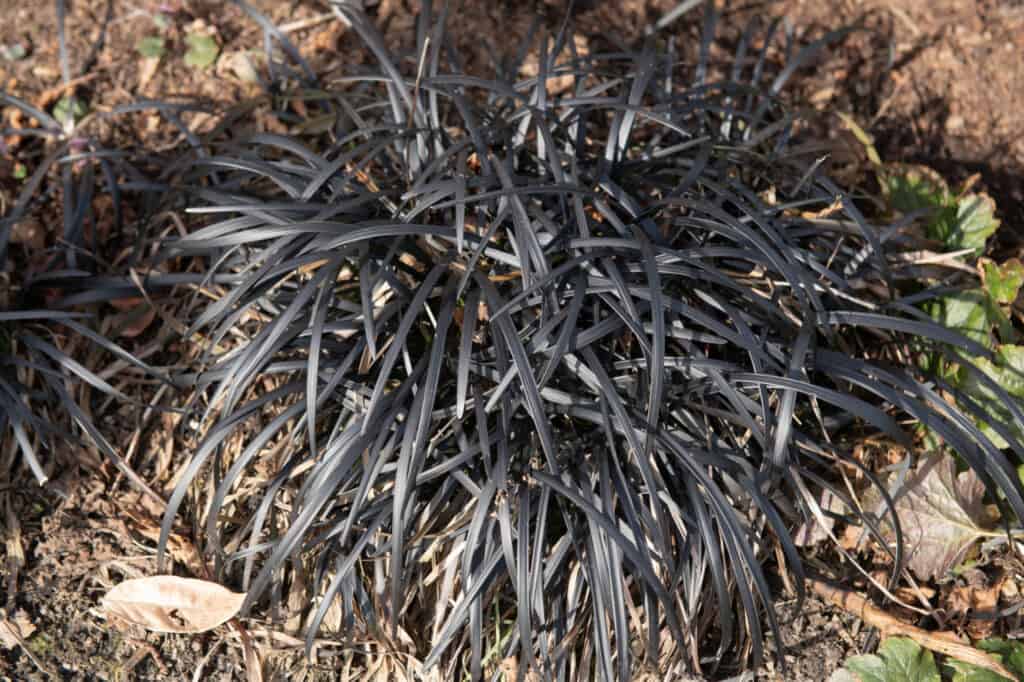
Ornamental black mondo grass grows best in full sun.
©Peter Turner Photography/Shutterstock.com
How Often Do You Water Mums: Recap
Let’s recap on our original question, “How often do you water mums?” The answer is: before they dry out, and the only way you can tell for sure is by checking the soil. Too much water rots their roots and causes mold, but when mums dry out, they drop their glorious flowerheads.
In general, container mums need water every other day, but in dry spells, a daily drenching might be required. Border mums need less, but in summer and early fall, probably twice a week is essential. You can cut down water usage by applying damp-trapping organic mulch to their roots.
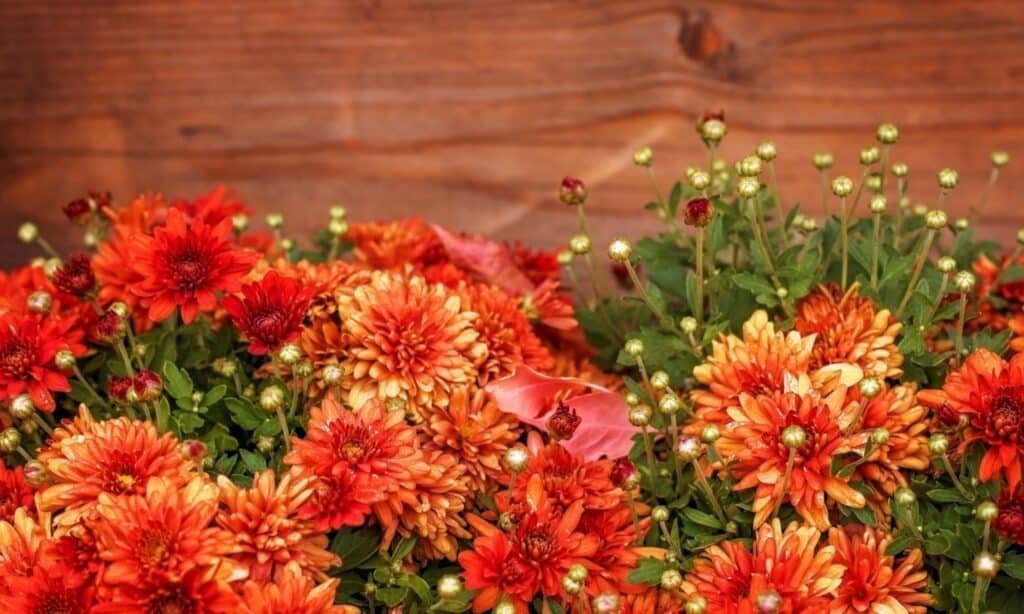
Check container grown mums soil every day because dry mums can’t develop new flowerheads.
©iStock.com/Svitanola
Thank you for reading! Have some feedback for us? Contact the AZ Animals editorial team.








